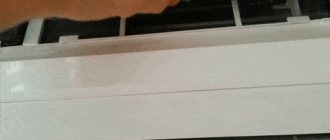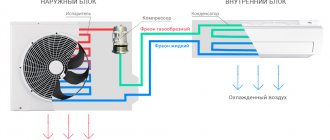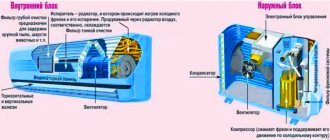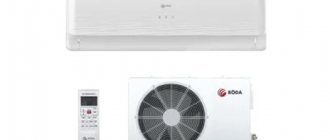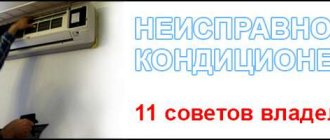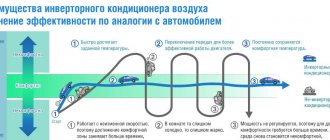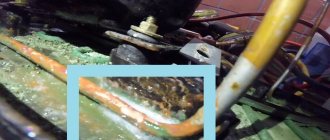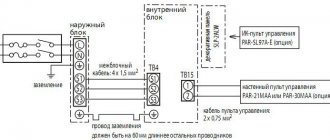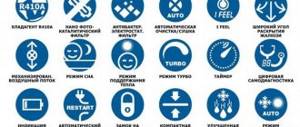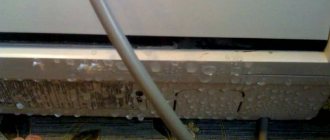Is it possible to dismantle the air conditioner with your own hands?
It is enough to have a pre-purchased specialized tool on hand, know some technical subtleties and take your time. The question arises: why waste time and effort if you can call the appropriate specialists who will perform the necessary operations in a short time? You can, but there are two reasons why you shouldn't:
- Price is the most important aspect. The average pricing policy for dismantling a modern split system is 4,000 rubles. We are talking about small apartment models. If the device has substantial dimensions and is installed mainly in offices, then the price will rise to 10,000 rubles. Quite significant for the budget.
- The likelihood of ending up with low-quality “specialists”. The modern desire of the population to do their own business leads to the massive appearance of people who do not understand the work they do. Also with some air conditioning “masters”. Therefore, the chance increases that the procedure will be performed poorly at a high cost.
But it should be said right away that manually removing a split system cannot always be successful. A common problem is the complete leakage of freon, which is quite expensive, and the price of a new one is at least 1,500 rubles. Therefore, when removing the air conditioner with your own hands, all actions should be performed accurately.
The necessary tool and its possible replacement
If you have the means, you can hire a specialist to remove and install modern split systems, without even paying attention to the manufacturers of this tool, which changes the pricing policy. But then the point of independent dismantling, which is carried out in order to save money, disappears. Therefore, some types of tools are best replaced with cheaper ones, and some will have to be abandoned altogether.
List of tools required for disassembly:
- Gauge manifold. This is a necessary thing, as it will show the pressure when pumping freon into the outdoor unit. And this particular measuring device falls into the category of tools that you should discard (at your own peril and risk), since its minimum cost is 1,500 rubles. A more reliable one will cost 3000-3500 rubles.
Example of a pressure gauge for split systems
- Set of hexagons. This position is mandatory, since the fitting cannot be unscrewed any other way. Fortunately, the price of such keys is not exorbitant - 3000-350 rubles.
- Pipe cutter It is inexpensive (about 300 rubles), but you can reduce costs even further and purchase an ordinary hacksaw, which will later be useful for housework.
- Flat and figured screwdrivers. Now they are sold in any hardware store or hardware store.
- Safety equipment if the air conditioner is located on upper floors. It’s not worth saving here, and not paying for a product whose cost is less than 1000-1500 rubles.
And one more prerequisite is the presence of an assistant, or preferably two. Both the external and internal units have a significant weight, so it will be problematic to handle it yourself; you can accidentally damage the device.
What to pay attention to when dismantling
The most fragile place in an air conditioner is the compressor pump. Despite its compact size, the design of such a pump includes complex mechanical components: rotors with cams, sealed system elements and a chamber in which the main work takes place.
If ordinary dust gets in, the walls of the chamber may be damaged, and accordingly, freon will move aimlessly around the system without performing any useful work. Therefore, the main slogan when dismantling the air conditioner is to preserve the vacuum in the system, which, in turn, requires the tightness of all external openings.
Consequences of improper dismantling
Here are a number of possible consequences if you dismantle the air conditioning system incorrectly manually:
- Loss of tightness of the cooling circuit and leakage of freon. Eliminating this unpleasant situation will require significant financial investments.
- Clogging of the internal circuit of the system with dust, penetration of moisture. These circumstances especially affect the functioning of the compressor, and the operation of the air conditioner in general. Therefore, the product should not be removed in rainy or snowy weather.
- A heavy outdoor unit falling from a height. Even if the product falls from a small height, in most cases this will lead to its breakdown and replacement.
- Mechanical damage to the surface of the external module and other elements, which can cause depressurization of the circuit. Even the slightest crack can cause gas leakage and dust and moisture getting inside.
Main types of removal: with and without freon preservation
How to remove or hang the air conditioner from the wall without losing freon? As mentioned above, freon is quite expensive, and when removing the air conditioner yourself, it should be saved. But if the service life of the device is long, and the freon needs to be replaced, then when moving, you don’t have to save it, but simply drain it and dispose of it.
If you decide to keep the freon, then the sequence for removing the air conditioner is as follows:
- On the outside of the split system there are service valves with protective caps covering special slots. To access the slots, the caps should be disassembled and the hexagon should be installed only in the valve on the thin tube located at the bottom of the device.
Removing special hex splines
- Now you should set the lowest air cooling temperature and turn on the device at maximum operating mode. Some models have a turbo option.
- After switching on the enhanced operating mode, the valve (with the hexagon installed) should be tightened. From this moment, the system must operate for at least one minute, during which all the freon will flow into the external unit.
- After freon is pumped into the outdoor unit, the gas line is shut off and the device is turned off. It should be remembered that continuing to operate the air conditioner in this mode with two valves closed will lead to damage to the split system.
- Unscrew the nuts securing the copper lines covered with a heat-insulating layer, which should also be removed. Now the tubes bend neatly and can be removed through the hole in the wall.
An assistant is required when removing the external unit
After completing all of the above operations, you can begin to directly dismantle the air conditioner, which is best started by removing the external unit.
It is very important to remember that the pipes should be sealed after removal. Often, simple adhesive tape, film or electrical tape is used for this. A more reliable way is to close them using simple pliers. If you approach the problem with full responsibility, then the ends of the pipes should be securely closed using a bench vice, thus preventing the penetration of moisture and dust into the evaporation chamber.
Features of work in winter
In cold weather, it is almost impossible to pump refrigerant into the condenser: the oil thickens greatly, and if you try to connect the air conditioner in this situation, a blower malfunction can easily occur . This situation is not terrible for air conditioner models that are equipped with a special winter kit. The equipment includes heating of the compressor crankcase and drainage, as well as a fan speed retarder.
If you have a model installed without this configuration, then freon can be pumped through a pressure gauge station to collect gas.
This station is connected to the shredder valve, similar to a pressure manifold.
How to properly and quickly dismantle the external unit of a split system
This procedure should not be performed if the system is installed on the upper floors of a multi-story building. This can be life-threatening.
Removing the external unit on the upper floors
Removal of the external unit of the split system occurs only after all the above operations have been correctly completed. Dismantling should begin by disconnecting the input electrical cable, the wires of which are suitable for the air conditioner terminal box, located under a special protective cover. To simplify the connection of the device at a new location, the wires should be marked with the appropriate colors (red - phase, blue - zero, yellow-green - ground).
All that remains is to unscrew the nuts that secure the air conditioner to the brackets. This is not a problem, but an assistant is needed to support the external unit during the entire process. Once the nuts are unscrewed, you can carefully remove the unit and prepare it for transportation.
Don't forget the brackets to which the air conditioner is attached. They are usually mounted using dowels to the outside of the wall, and dismantling takes a little time.
You should know that split system manufacturers strictly prohibit the transportation of devices into which freon is pumped. Why? The answer is simple: after all the above actions, excessive pressure forms in the system, and the air conditioner housing is not designed to withstand even the slightest mechanical impact. Therefore, without the necessary conditions (covering the block with a sealant or special film), the block body can simply break through. This can be understood by the characteristic hissing.
Removing the indoor unit
After the external unit has been dismantled, it is necessary to dismantle the internal (located in the room) air conditioner unit. There are fewer problems with it, since there is no need to work even at low heights, but there is a certain dismantling procedure and additional tricks.
Don’t relax and think that it’s enough to unscrew a few nuts, remove the indoor unit, and send it to a new place. The main trick lies in the desire of air conditioner manufacturers to make the process of removing the device as inaccessible as possible for craftsmen. That is why each indoor unit has a latch system with which it is attached to the wall. You can only work with such fasteners using a special tool, but there are no hopeless situations, and it is quite possible to choose something simpler.
Two screwdrivers will help you quickly remove the latches
Another tip: when removing a block, it is best to have not one assistant, but two. This is due to the fact that the indoor unit is quite bulky and heavy, and one person may simply not be able to handle it.
The two most common options for removing the indoor unit are:
- The simplest design is sometimes the most complex, which is why manufacturers of split systems try to hide the latches under the evaporator cover. The cover bolts are located inward, so to unscrew them you will need a special short bit in the form of a shaped screwdriver and a head with a ratchet.
- In addition to securing the evaporator cover, they try to make the latches themselves internal. If you don't have a special tool, you can use two flat-head screwdrivers and push them between the bracket and the wall. Now it’s enough to press a little (you shouldn’t be too zealous, they can be removed without effort), and an assistant can easily remove the internal block.
Removing the indoor unit with an assistant
There is one circumstance that can significantly interfere with work - the presence of a large number of evaporation tubes, and they are usually located near the mounting brackets. Therefore, when working with brackets, you should be as careful as possible so as not to damage them.
How to turn off electrical circuits
The last step before dismantling is to disconnect the electrical circuits. This can only be done after removing any remaining refrigerant. Finding the shutdown location is very simple - most often it is located on the back side of the outdoor unit of the air conditioner.
If you can’t find a diagram, or it seems too complicated, then you should sketch out the entire diagram before turning it off. Only those conductors that go from the indoor module to the outdoor unit should be disconnected. In addition, it may be necessary to dismantle the network supply. This is quite difficult to do, since it is located inside the building.
Once everything is disconnected, you can begin to remove the outdoor unit from the brackets. If you do everything according to the instructions, then there will be no problems with subsequent installation and switching on.
How to properly re-hang an air conditioner
Situations often arise in which relocating an air conditioner is more important than completely dismantling it. In this case, one of the blocks is left in its place, and for the second the tubes are simply extended. The process of removing both the internal and external units is no different from those described above, the only difference is the need to build up copper or ordinary pipes.
When dismantling one of the units, you should also monitor the safety of freon and pump it into the outdoor unit before carrying out all operations. After undocking the split system, it is necessary to rehang it as carefully as possible, without damaging the air conditioner housing. To save more money, you don’t have to do the soldering of pipes yourself, but entrust this task to specialists. Split system service technicians have a corresponding column in their price list, which is called extension of the interblock route.
How is freon discharged?
There are several ways to remove a working air conditioner.
- An ordinary pressure gauge station is used. With its help, all freon is pumped out.
- Using a special station connected to a cylinder with two valves. Such a device pumps out liquid and gaseous freon.
The first option is considered simpler. However, this requires running the air conditioner. But you can do this only if it’s not too cold outside.
The second option is more complicated, but it can be used in almost any situation, even when it’s cold and turning on the air conditioning is prohibited. In addition, this method has another advantage: freon will be completely pumped out of the condenser. Thanks to this, it is possible to transport the air conditioner from place to place.
The use of such a station allows for dismantling in winter
However, this method also has disadvantages. The main one is the high cost of renting a station and a cylinder, which is very different from the price of a simple manometric manifold.
Some useful tips
Having prepared the necessary tool, read the instructions and watched the corresponding videos on the Internet, you should also learn several important subtleties:
- Both when completely dismantling the split system, and when partially moving the device, you should not worry too much about the safety of the copper pipes. Replacing them will not cost too much money and installing new ones is always better than repairing old ones.
- If it is difficult to understand which pipeline is liquid and which is gas, then you need to pay attention to the diameter of the pipes. The liquid pipeline, which is also the outlet pipeline, is always thinner than the gas supply pipeline.
Examples of pipes on an air conditioner
- During transportation, the system should be covered with any seal, since any blow to the housing can lead to loss of freon or failure of the device.
And the most important advice is never to rush, since these systems require precise and careful movements; strength will not always help here.
